Content
- 1 Description of late cabbage
- 2 Growing features
- 3 The best varieties of late-ripening cabbage
- 4 Varietal variety of white cabbage
- 5 Most Popular
- 6 Late varieties of cabbage
- 7 Cabbage varieties for long-term storage
- 8 Dutch varieties
- 9 The best varieties of cabbage for pickling
- 10 White cabbage variety "Kolobok F I"
- 11 Kohlrabi - the best varieties
- 12 Late varieties of red cabbage
- 13 Choosing the best variety of cabbage
For salting and long-term storage until spring, winter (or late-ripening) varieties of cabbage are most suitable. It is them that summer residents prefer to grow in order to prepare enough of this useful vegetable for the winter to feed the whole family.
Growing white cabbage
Description of late cabbage
Many late varieties have been bred. They differ mainly in the duration of ripening. While early varieties take three months from germination to fully ripen, mid-season varieties may take four months, then some varieties of late cabbage mature only six months after the start of growth from seeds.
Description of late cabbage
This long wait is rewarded:
- equally long shelf life;
- high yield of varieties;
- excellent transportability of heads of cabbage;
- readiness to preserve all valuable substances, taste and textural properties during salting, pickling and fermentation.
By the way! Varieties intended for long-term storage improve their palatability over time. In addition, in cabbage, unlike other vegetables and root crops, nitrates do not accumulate during the time it is stored.
Cabbage
The second difference between different types of cabbage ripening in terms of maturation is agricultural technology. In general terms, it is similar not only for all cabbages, but also for many crucifers. But the timing of sowing, germination, planting and some growth conditions differ in detail in late cabbage from its mid-ripening and early-ripening "relatives".
By the way! Some varieties of late-ripening cabbage can stay intact, under appropriate conditions, until the next harvest.
Growing features
Growing cabbage in a greenhouse
In different regions, depending on the climate, the seeds of late cabbage varieties are planted at different times. But always, in all climatic zones, this is a seedling method of growing. For late varieties, seedlings are grown at home (in extreme cases, in a heated greenhouse or greenhouse). In the southern regions, it is possible to sow seeds on a special seedling bed under a film cover.
Stimulation and disinfection of seeds
Seeds
Before sowing late cabbage seeds, they need to be disinfected. Soaking in hot water is sufficient for disinfection. The temperature should not be higher than + 45 ° С. It is necessary to keep cabbage seeds in water for a quarter of an hour, placing them first in a rag bag.
Disinfection of seeds
How to keep the required temperature in the container for a certain time?
- Put a dish of water on the heater (after checking the temperature of its heating in advance for half an hour).
- Put the container in another container, pouring water into it, ten degrees hotter (a kind of water bath, just not on fire).
- Disinfect seeds in a multicooker on the "Yogurt" mode.
Important! The heating procedure will not only destroy the microbes that may be inside the seed, but will also contribute to the speedy germination by activating the growth point of the embryo.
Disinfection of seeds with potassium permanganate
After disinfection by heating, the seeds must be quickly cooled by lowering them for one minute under cold running water.
Soaking the seeds in a fertilizer solution will help accelerate germination and make the seedlings even more uniform. It can be any mineral complex. It is best to take a regular nitrophoscope. The proportions for the preparation of the solution are 5 g of granules per 500 ml of water. Room temperature water. Dissolve thoroughly. Keep seeds for 12 hours.
Preparation of seedling containers and soil
Cabbage dives well, so it can be grown initially in any convenient or available containers. If pots are available, use pots. There are boxes, sow in boxes.
Peat seedling pots
It is more convenient to plant cabbage on a ridge or in a greenhouse from individual pots with a diameter of about 8 cm. By the time they move to the garden, the seedlings should have four adult leaves.
The soil for sowing cabbage does not need heavy. Peat is traditionally used. If possible, part of the humus is mixed with part of the sod land, sand can not be added. Both peat and mixed substrate must be seasoned with wood ash. About a tablespoon is used per liter of substrate. The ash is sieved before this. Then it is thoroughly mixed with the soil.
Soil for cabbage seedlings
If you have not steamed the soil mixture, then be sure to spill it with Trichophyte solution or pink potassium permanganate solution
Sowing
You can sow late cabbage seeds at the end of February. It can take up to 60 days before planting seedlings in the garden. The latest sowing dates for late varieties are mid-March. Sowing later in the middle lane is impractical, the heads will not have time to ripen.
Advice! If you are late with sowing late-ripening varieties, sow mid-ripening ones. Some mid-season varieties, for example, "Gift", are stored for up to four months, have good data for canning and can be used fresh.
Spread the seeds
Add seeds
Sowing takes place in shallow grooves, about 2 cm deep. The distance between the crops in the box is 5 cm.When two full-fledged leaves appear, the seedlings will have to be thinned so that the distance between the seedlings is at least 5 cm.If you are sowing in a pot, place 3-4 seeds at the corners of an imaginary square, on top of the soil. Fill on top with a two centimeter layer of peat. Crops are watered and covered with foil.
Place the bowl in a plastic bag and keep the sowing until germination at a temperature of about 20 ° C
After germination, which appears on the 5-7th day, the film is removed immediately and is no longer used.
Watering cabbage seedlings
Preparing the cabbage bed
Preparing the cabbage bed
Late varieties need a lot of sunlight, heat and moisture for the heads of cabbage to mature fully. Only finally ripe heads of cabbage can be stored all winter until summer. Therefore, the landing site is chosen open. The soil is fertilized with organic matter in the fall. Cabbage loves organic fertilizers - this is the best fertilizing option for this plant. Late cabbage especially needs fertilization of the soil. Up to 7 kg of rotted organic matter is used per 1 m². Can be fertilized with plant compost. But animal organic matter in addition, in the form of a solution, should be used for pre-plant feeding and for periodic feeding, of which at least three are carried out during the growing season.
Transfer
Seedling cabbage
At the end of April, holes are dug in a dug ridge according to the number of seedlings. Seedlings move into moist soil, with a moist clod, do not burrow. Watering is necessary abundant. The first feeding is carried out on the twentieth day after planting.
Cabbage planting scheme
Planting cabbage in the ground
Planting cabbage seedlings
Fill the hole with water
The hole is kept free of weeds. The soil is loosened. After the beginning of the formation of the outer stump, the plant must be spud.
The best varieties of late-ripening cabbage
There are not so many varieties of cabbage, unlike other garden vegetables. Against several hundred varieties of tomatoes, cucumbers, peppers - only a few dozen early, medium and late cabbage varieties. Some of them, moreover, were bred back in the USSR from numerous hybrids, so they cannot be called the best. The most popular, most frequently and successfully grown are the following late varieties.
"Aggressor"
Aggressor is a popular hybrid variety
Marked "F1", it is a hybrid in the first generation. It can be grown in any region. Its characteristic features are delayed development at the stage after planting seedlings; unpretentiousness and ease of plant care.
By the way! This variety grows with little or no maintenance. In any case, you do not need to look after him as carefully as for his brothers. You can "forget" to water, feed (withstands a lack of nitrogen and drought).
Aggressor F1
Color - green with blue. There is a waxy coating. The structure of the head of cabbage is of high density. The hard, knocked down fruit reaches five kilograms. Grown within four months. After 120 days from germination, it reaches full ripeness. Almost no cracking occurs, prolonged cleaning is possible almost until the first frost.
The variety is resistant to black leg, not affected by fusarium, thrips, not susceptible to late blight. One of the best for fermentation, stored in heads of cabbage for five months.
Video - Cabbage "Aggressor F1"
"Mara"
One of the most popular varieties of Belarusian selection. The growing season is long - up to 165 days. Heads of average weight - 4 kg. But the taste is exceptional. Used for fermentation whole, heads, kept fresh for about eight months, until early May. Differs in high productivity.
White cabbage. Variety "Mara"
Bluish waxy bloom on the thick outer leaves is pronounced. The variety is grafted with resistance to rot.
"Moscow"
White cabbage "Moscow" late
This is a giant variety. The heads can be up to ten kilograms. Ripens, however, in just 130 days. It is considered one of the most productive varieties. The surface color is green-gray. The inside of the section is white with yellowness. The taste is not just good - it is excellent. Lots of sugars, ascorbic acid, minerals.
By the way! Able to endure temperature drop down to -6 ° C ... 8 ° C. Therefore, the dates of disembarkation and harvesting can be shifted to an earlier (spring) and later (autumn) time.
Moscow cabbage
With a dense consistency, it is juicy. Resistant to cracking and most cruciferous diseases. Only slugs and aphids need processing.
Stored at + 5 ° C for 9 months or more.
"Amager"
"Amager"
The variety is ideal for fermentation and the production of any blanks. The heads are small - up to five kilograms. The density is increased. The color is green-gray with a bloom. White inside. There is resistance to root rot and fungal infections.
By the way! It is a cold-tolerant variety, but it does not tolerate heat well and reacts negatively to drought. Therefore, it needs additional watering.
The growing season of the variety lasts 160 days. The average shelf life is up to six months. Therefore, this variety is best used to create winter stocks of pickles. Perfectly transported, not prone to damage, does not crack, cleaning can be done mechanically.
"Megaton"
Cabbage "Megaton f1"
The earliest among the late hybrids, after the leader of the "Aggressor". The growing season is within four months. The head of cabbage grows dense, weighing up to 5 kg. This is a Dutch hybrid, and the breeders took care of the "brainchild" as much as possible, providing it with immunity not only to diseases, but also to insect damage.
Excellent transport capabilities.Quite high taste parameters. It is not stored for long - five months. Used for fermentation. Needs frequent watering and an increased rate of mineral fertilizing.
"Snow White"
Cabbage "Snow White" (late)
A late variety, it is considered universal, since it is suitable both for storage for eight months, and for all types of salting and canning, as well as for fresh consumption.
By the way! High healing properties of this variety of cabbage and its increased nutritional qualities are noted. It is considered beneficial for children as it supplies many of the nutrients needed by a growing body.
Fully ripe forks reach 4 kg. The growing season is 160 days. Leaves of beautiful turquoise color, white dense inside. Not damaged by delayed harvest and transportation.
"Valentina"
"Valentina"
A very popular variety among gardeners of the middle lane. Domestic hybrid. It ripens for a long time - up to 180 days. The weight characteristics of a head of cabbage do not exceed 4 kg. Stored for 8 months. But with all these "ordinary" qualities, "Valentina" is distinguished by outstanding taste qualities. It is characterized by high sugar content, crispness, and fork density. Use is possible in all cabbage "hypostases". But best of all, besides perfect storage, cabbage tolerates pickling.
White cabbage "Valentina"
"Kolobok"
"Kolobok"
Also a popular hybrid with perfectly rounded five-kilogram heads that ripen within 150 days. Wax bloom is pronounced. The middle is snow-white. A very dense head of cabbage. Stored for 7 months. Can be used for fermentation. This variety, with such "alright", one-to-one heads of cabbage, is distinguished by high marketability, simultaneous ripening and ease of harvesting. Does not require specific maintenance. It is susceptible to cabbage diseases and pests.
"Sugarloaf"
Cabbage variety "Sugarloaf"
The speaking name of this late variety indicates its high sugar content. There is absolutely no bitterness in it, so it is used mainly fresh. Not only organic sugars are contained in it in large quantities, but also many minerals, and a number of vitamins, led by ascorbic acid.
Sugarloaf giant cabbage
By the way! Resistance to fusarium, bacterial diseases, keel and an eight-month shelf life contributes to the popularity of the variety.
After 160 days from the beginning of the growing season, the heads of cabbage gain a mass of 3.5 kg. This is quite a bit when you consider that some varieties grow three times heavier. But the nutritional value is taken into account when choosing a cultivar for cultivation, so Sugarloaf is not in the last place among the popular late cultivars of white cabbage.
"Lezhky"
"Lezhky"
This hybrid, named eloquently for its properties (high keeping quality), has, nevertheless, a very small weight, and therefore size, heads of cabbage. The maximum up to which the forks grow is 3 kg. Ripens for 155 days. Has above average palatability immediately after harvest. Then, during storage, they rise significantly. The variety can be stored until June, a full nine months. Moreover, they even begin to ferment and preserve it not immediately after collection, but in the middle of the shelf life. At this time, around February, the heads of cabbage reach the highest sugar content.
"Triumph"
"Triumph"
An extremely late ripening hybrid, ripening 175 days. The mass of a head of cabbage does not exceed 4 kg. Recommended by summer residents for cultivation for a long and good keeping quality. Storage is possible up to 8 months. It tolerates all types of canning perfectly, keeping the vitamin composition unchanged. High juice content. Above the average density of a head of cabbage. Not prone to fusarium wilt. The yield is strong.
"Filibuster"
"Filibuster"
This "pirate" variety is a mid-late hybrid. It is preferred for a relatively short ripening period of 130 days. Small heads of cabbage - 3.5 kg.Shelf life to late varieties does not hold out, shelf life is no longer than 5 months. But you can ferment and preserve immediately after harvesting. Taste characteristics are equally high for both fresh and canned products.
Table. The timing and duration of the main stages of growing popular late varieties of white cabbage
| "Aggressor" | 50 | 120 | 5 |
| "Mara" | 60 | 165 | 8 |
| "Moscow" | 55 | 130 | 9 |
| "Amager" | 60 | 160 | 6 |
| "Megaton" | 55 | 130 | 5 |
| "Valentina" | 60 | 180 | 8 |
| "Kolobok" | 55 | 150 | 7 |
| "Sugarloaf" | 60 | 160 | 8 |
| "Lezhky" | 60 | 155 | 9 |
| "Triumph" | 60 | 175 | 8 |
| "Filibuster" | 50 | 130 | 5 |
5 best ways to store cabbage
Video - Planting late cabbage
.
One of the healthiest vegetables is cabbage. This vegetable is very versatile in its use. In winter, late varieties of cabbage are actively used.

Late varieties of cabbage are not afraid of autumn frosts
Features of late cabbage
Late white cabbage species are endowed with the following qualities:
- yield rate;
- ability to preserve (up to 9 months);
- the possibility of mechanized harvesting;
- use for fermentation;
- breeding for resistance to diseases, pests.
The ripening period of late cabbage from sowing the seed to harvesting takes 190 days. But such varieties are not afraid of autumn frosts. Under these conditions, late cabbage heads form faster. Such cabbage is afraid of frost in the spring, so they must be grown in seedlings.
Depending on the region, the process of sowing the seed takes place at different times.
It is important to disinfect the seed before sowing.
What are the best varieties of late cabbage
The best cabbage varieties are those that keep well. These vegetables can be stored until mid-spring. But there are varieties that can be preserved until the new cabbage is harvested. It is important that the density of the vegetable and the flavoring properties hardly change.
It is believed that hybrid species are best suited for long-term storage.
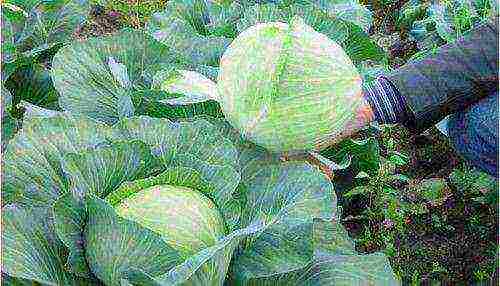
Aggressor is a popular hybrid variety
Aggressor
It is a late hybrid variety of white cabbage. A very popular Dutch species grown in all regions of our country. Slow ripening of the fruit forms the firmness of the head of cabbage. Doesn't require thorough maintenance at all. It can grow even under not so good conditions, without cracking. The selection of this variety, the selection is developed for the resistance of the vegetable to many diseases: late blight, black leg, fusarium. The aggressor is resistant to aphids, caterpillars, cruciferous flea beetles. This is the best vegetable for pickling and storage.
Mara
In the Belarusian selection, it is the best variety. The ripening period takes 170 days. Ripe fruits weigh 4 kilograms. The color of the head is dark green with a visible waxy coating. Mara is a white-headed species and can be stored until the first days of May. Has excellent resistance to rot and damage. An excellent variety for fermentation.
Moscow
An excellent choice of white cabbage for storage. A feature of this variety is its high yield. The weight of a ripe head of cabbage can reach up to 10 kilograms. The head is dense, overall flattened.
Stored for a long time (until the first fresh harvest). The breeders have provided this variety with high resistance to keel disease, which makes it possible to have a good harvest.
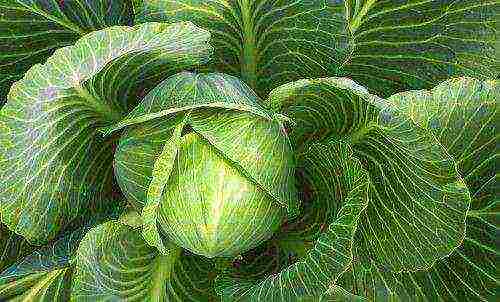
A feature of the Moscow cabbage variety is its high yield.
Amager
The best choice of white cabbage for pickling. Amager is a juicy, high-yielding variety. The head ripens up to five kilograms of mass, dense. Among similar white-headed species, this is an important property.
The upper part of the head of cabbage is endowed with a green tint, but when cutting amager, the shade becomes white. It is excellently stored in winter, well preserved when moved. It is resistant to rot and fungi. The vegetation stage lasts 160 days. Amager prefers moisture and needs to be periodically fed with mineral fertilizers.
This variety is unsuitable for fermentation, because after ripening it has a coarse leaf quality and a bitter taste, although closer to spring, the bitterness disappears.
Snow White
A practical variety of late cabbage. It lasts up to eight months. Experts point to the good healing qualities of the vegetable. Very useful for children. But, it is recommended to store at a temperature not lower than +8 degrees.
Megaton F1
This is the fastest maturing species among the late varieties - up to 130 days. The mass of one ripe fruit can be up to five kilograms. During the selection process, Megatons F1 developed very good resistance to fungal diseases and insect pests. The variety is convenient for transportation.
Megaton F1 is a Dutch cabbage, but quite popular in many countries. The shelf life is about five months. During the growing period, it is necessary to comply with watering norms and feed with organic fertilizers. Usually organic matter is introduced in the first days of growth and 35 days after planting seedlings in open ground.
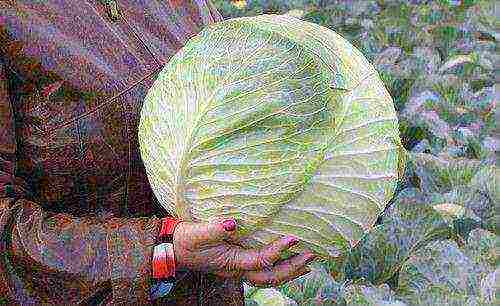
Megaton F1 is the fastest maturing late variety
Gingerbread man
A high-yielding cabbage variety that ripens 150 days after sprouting. Round heads with good density, weighing up to 5 kg. It has a selection for resistance to cracking. The head of cabbage is green on top, and white when cut.
The gingerbread man is endowed with resistance to bacteriosis, fusarium leaf wilting to rot... A good choice for winter storage and fermentation. With the right content, this species can persist until May. Seeds are sown in mid-April.
After ripening, Gingerbread man has a bitter taste, but over time, the bitterness disappears.
Wintering
Is the best domestic breeding for storage. The growing season lasts four months. The fetus is preserved for up to eight months. Waste during storage has a low percentage. The selection of the variety is resistant to cracking, necrosis throughout storage. Can be used for fermentation.
Based on this information, each gardener can choose which varieties of late cabbage to use for their garden and their own purposes in the winter: preference for pickling or storage.
Subscribe Be aware of new products on our site
White cabbage is an incredibly healthy vegetable with a rich vitamin and mineral composition. This explains its popularity among gardeners. The cultivation rules are not complicated, but the basis for the yield depends on the choice of the variety.
Varietal variety of white cabbage
In the old days, there was really a shortage of seed material due to limited supplies from the near and far abroad, therefore, the seeds were often harvested from the usual varieties.
For more than 20 years, the situation has changed radically, and the varietal assortment of many gardeners continues to consist of 2-3 positions. And in vain, because new developments have no less valuable qualities, which consist in resistance of cabbage to diseases and pests.
This is especially important when you consider that the moisture-loving plant literally attracts insects and fungi.
This article discusses early, mid-season and late-ripening varieties of a popular vegetable with a description that will expand the variety of crops grown in your garden and in the Urals and in the middle lane.
Most Popular
The variety of cabbage is selected not only taking into account the winter and climatic characteristics of the region, but also by appointment... The mineral and vitamin composition of each plant is different, but it is also influenced by the conditions of agricultural technology and the type of soil.
In order to choose the appropriate option it was easier, the varietal assortment is divided into groups, united by a common feature.
The best late varieties of cabbage for long-term storage
Aggressor Is a mid-late hybrid developed by breeders from Holland.Differs in minimal care and resistance to fusarium, thrips damage.
Vegetation lasts up to 120 days, you can sow seeds directly on an open bed. A ripe vegetable weighs 3-5 kg. Shelf life and processing - up to 5 months.
 Aggressor
Aggressor
Amager - late cabbage with a ripening period 120-147 days... The heads are round-flat green, sometimes with a bluish tinge, weight about 3-4 kg.
When planting, the scheme is used: 3-4 plants per 1 m2. For six months, the nutritional value and presentation are preserved. Weather cataclysms and violation of the watering regime do not violate the density of the structure and the integrity of the head.
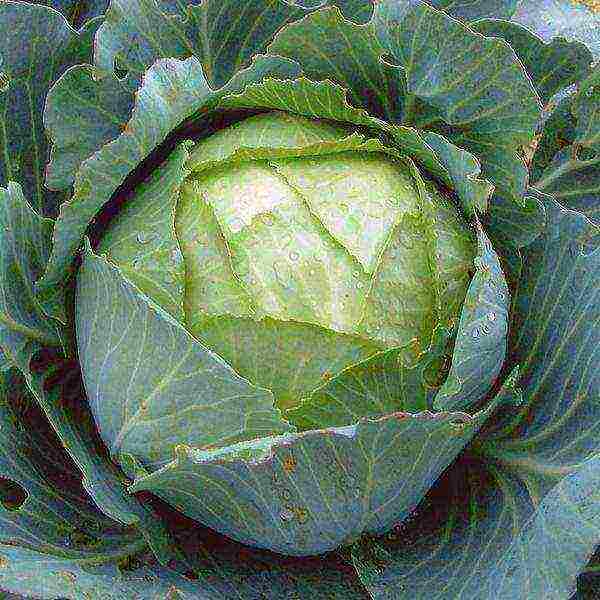 Amager
Amager
Valentine - growing season 155-180 days after transferring seedlings to open beds. The gray-green heads have a slight waxy coating, the weight tightens up to 4 kg.
Cabbage retains its taste and presentation until the beginning of the next season (June). The hybrid is tolerant to fusarium, gray rot. The head of cabbage does not crack due to violations of the moisture regime.
When planting, the scheme is used: 2-4 plants per 1 m2.
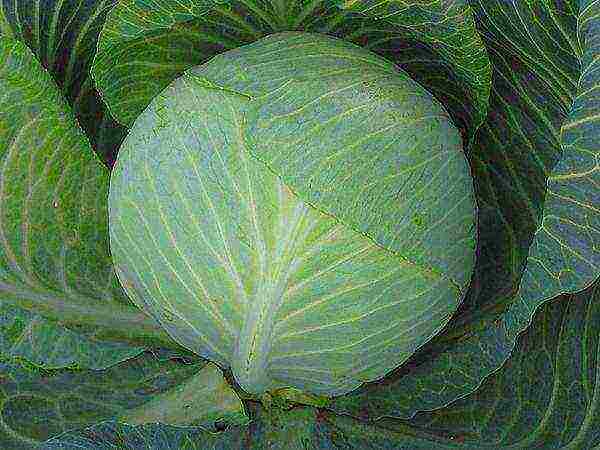 Valentine
Valentine
Gingerbread man - hybrid forms heads later 115-125 days after planting seedlings. Round fruits have a dense structure, the average weight is 2-3 kg. Planting scheme: 3-4 plants per 1 m2.
Due to its good immunity, it exhibits tolerance to punctate necrosis and thrips. For 8-10 months, cabbage retains its nutritional value and presentation.
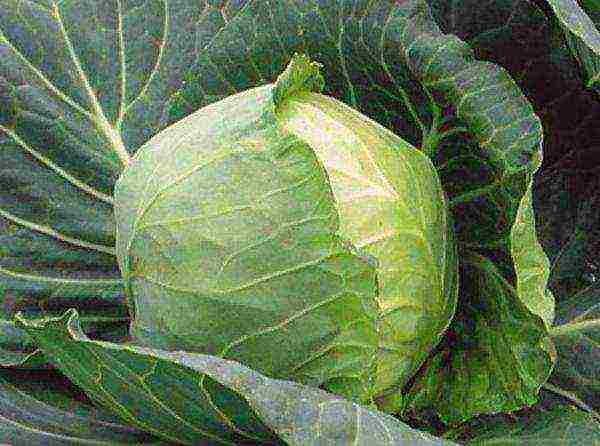 Gingerbread man
Gingerbread man
Mara - very dense heads are not susceptible to cracking, the average weight is 3 kg. The variety is distinguished by good taste, transportability and long shelf life (more than 7 months).
The main advantage is resistance to the accumulation of nitrates and radionuclides. Vegetables are harvested through 160-175 days after transplanting seedlings.
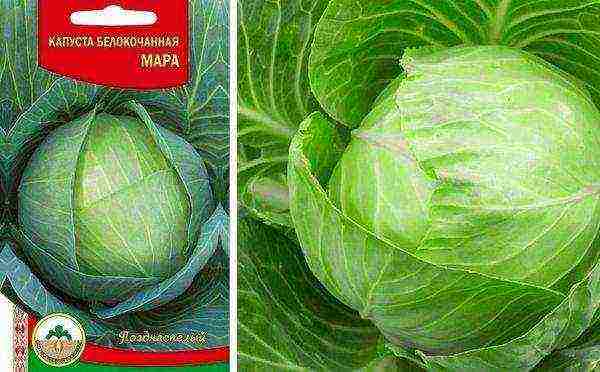 Mara
Mara
Moscow - a variety developed by domestic breeders, who took into account the climatic features and possible problems with pests when growing.
Harvesting begins later 130-140 days after disembarking seedlings. Gray-green rounded heads of cabbage weigh 4-7 kg on average. When planting, the scheme is used: 2-3 plants per 1 m2.
Cabbage is resistant to cracking, has a delicate juicy pulp. Without loss of taste and presentation, the vegetable is stored for 6-8 months.
 Moscow
Moscow
Mid-season white cabbage
Megaton - the hybrid matures in 102 days after planting seedlings. The great need for moisture and fertilizers strengthens the immune system, which resists many diseases and insect infestations.
The round-flattened gray-green head weighs up to 15 kg. The location of the holes when planting: 3 plants per 1 m2. Duration of storage without loss of nutritional qualities and presentable appearance is 4-6 months.
Merchant's wife - a disease-resistant high-yielding variety, distinguished by simple agricultural technology. About 500 centners are removed from a hectare (head weight up to 3 kg). When planting, the scheme is used: 3-4 plants per 1 m2.
Harvesting begins later 130-150 days after transferring seedlings to the beds.
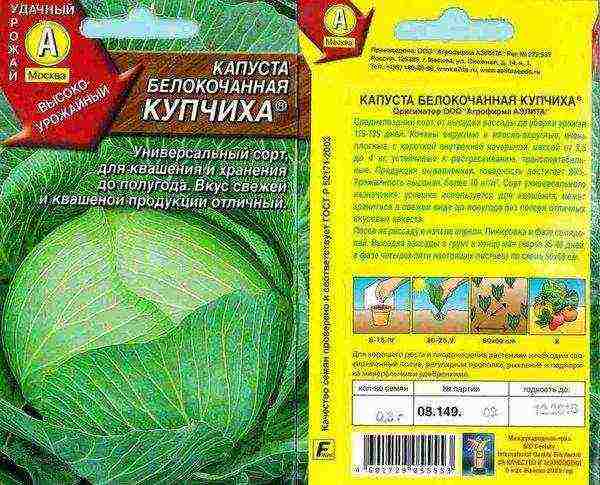 Merchant's wife
Merchant's wife
Atria - the fruit of the works of Dutch breeders with the growing season 110-120 days... The head of cabbage has a round-flat head of blue-green color, the average weight of which reaches 5-7 kg. Often there are specimens of 8-8.5 kg. When planting, the scheme is used: 3 plants per 1 m2.
Thanks to its good immunity, it resists pests (in particular thrips) and fusarium. The commercial and taste qualities are preserved for 4-6 months.
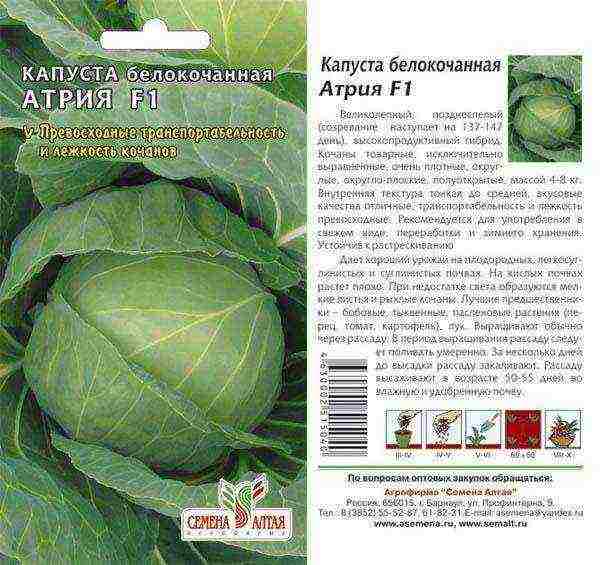 Atria
Atria
Glory - the fruit of the work of Russian breeders, the growing season is 120-130 day after planting seedlings.
Round heads have a light green color with a grayish tinge, the weight tightens up to 3-5 kg. When planting, the holes are arranged according to the scheme: 3-4 plants per 1 m2.
The advantage of the variety is its taste, the disadvantage is short storage (about 2 months). Glory is one of the best pickling options.
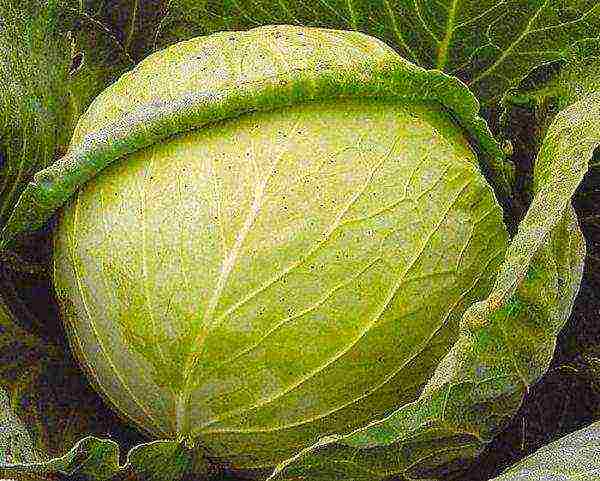 Glory
Glory
Sugar queen - the hybrid ripens after planting seedlings through 120-140 days... Dense rounded heads have a slightly greenish tint, weighing up to 4 kg.
When planting, the scheme is used: 3 plants per 1 m2. A universal variety, used fresh and for pickling. The shelf life without loss of valuable qualities is 3-4 months.
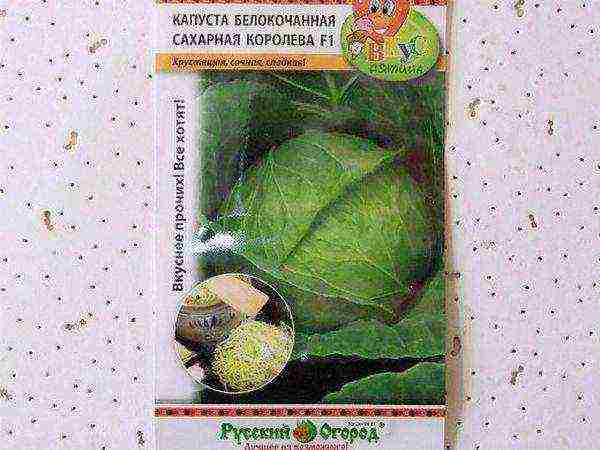 Sugar queen
Sugar queen
Early ripe
Rinda - the ripening period of the hybrid is 75-80 days after disembarking seedlings. Round heads weighing up to 7 kg have a green color and a dense structure. Hole layout: plant 3-5 plants per m2. Differs in unpretentiousness to weather conditions.
The shelf life without loss of taste and presentation does not exceed 4 months.
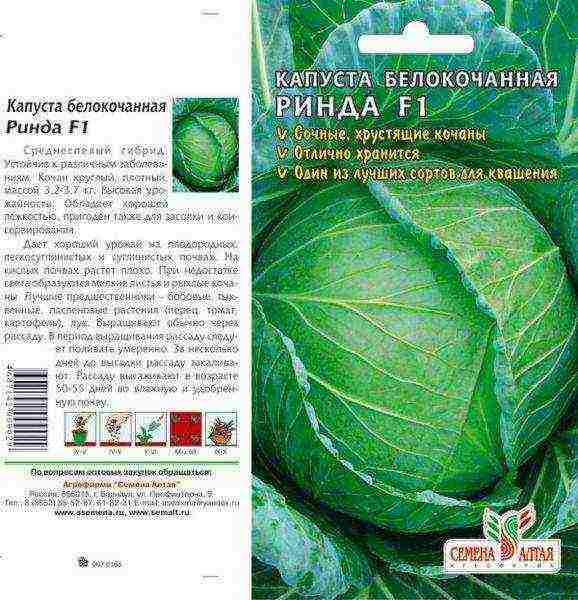 Rinda
Rinda
Kazachok - an early hybrid is distinguished by early maturity, you can harvest through 45-55 days after disembarking seedlings. The weight of the medium-sized light green head is 1.5 kg.
The scheme used for planting: 5-6 plants per 1 m2. Recommended for cultivation under any kind of film and in the open field. Cabbage resists the causative agents of mucous bacteriosis and black leg.
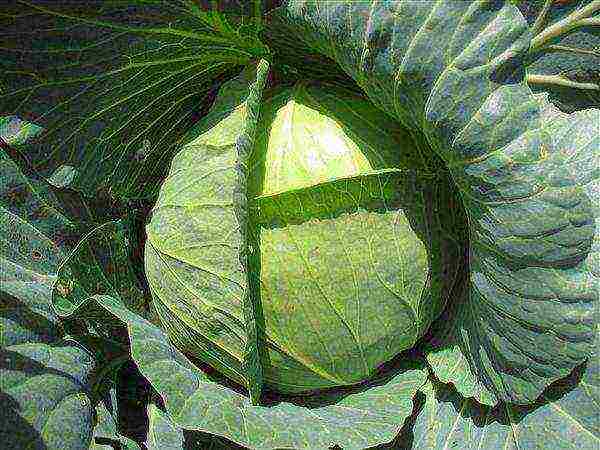 Kazachok
Kazachok
June - the variety is ready for planting in open ground already at the beginning of May, after 45-50 days you can harvest. The structure of the head is of medium density, the weight reaches 1.4-1.7 kg. When grown on highly fertile soils, the weight of the head of cabbage reaches 5 kg.
The layout of the holes when planting: 3-5 plants per 1 m2. Cabbage is distinguished by the amicability of the emergence of seedlings and excellent taste.
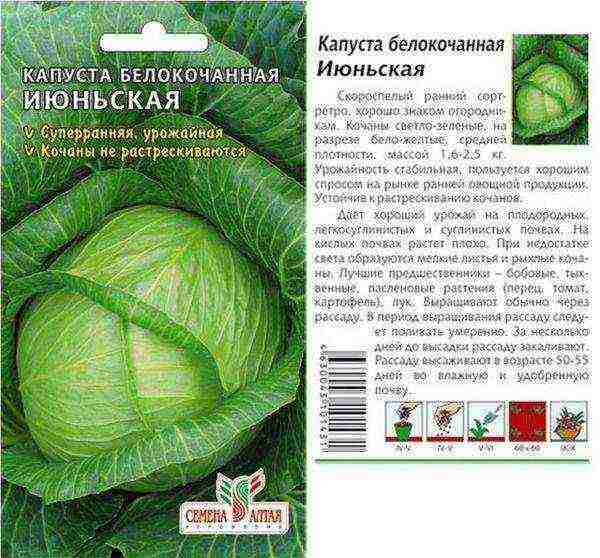 June
June
Tobia Is a Dutch hybrid characterized by resistance to fusarium wilt. The layout of the holes when planting: 2-3 plants per 1 m2. Round-flat heads of dark green color reach a mass of up to 7 kg. Fruit ripening occurs later 85-90 days after disembarking seedlings.
It has a strong root system, if the irrigation regime is violated, the head of cabbage does not crack. It retains its taste and marketability for 5-6 months.
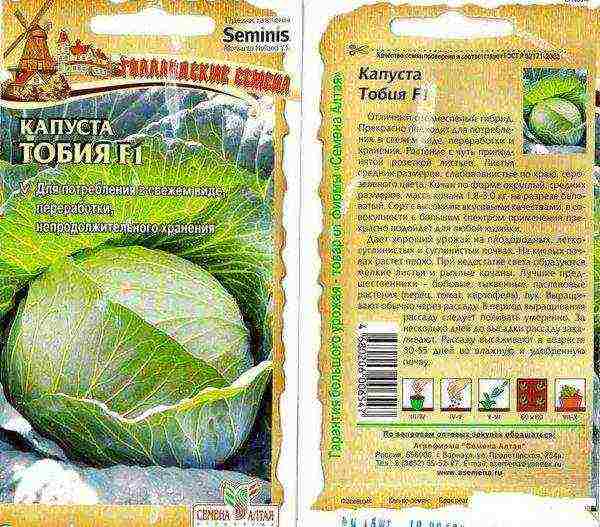 Tobia
Tobia
Varietal variety will ensure productivity even in difficult weather conditions, because each plant has its own immunity to diseases and pests. The taste qualities of the varieties stimulate new experiments, which continue already in the kitchen.
Cabbage is one of the most popular crops of Russian summer residents, not inferior in popularity to potatoes, cucumbers and tomatoes. This is due to the nutritional value, unpretentiousness and the ability to have this product in the diet all year round. Of course, not all varieties are suitable for long-term storage and fermentation. Breeders are constantly improving the resistance of cabbage to diseases and pests. What varieties are suitable for storage and have the best taste?
Late varieties of cabbage
According to the ripening period, cabbage is divided into medium-early (up to 135 days), mid-ripening (up to 160 days) and late-ripening (up to 220 days). Early and middle varieties have tender pulp and juicy leaves, but are highly susceptible to disease.
Mid-late and late-ripening cabbage varieties are resistant to damage by diseases and pests, have a dense head of cabbage with hard leaves, the taste is not always perfect, improving during storage.
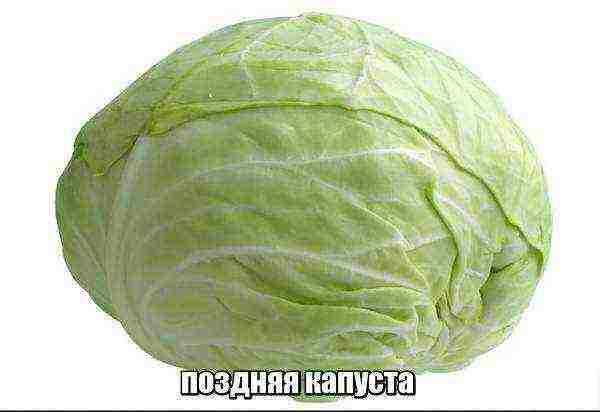
Late varieties tolerate short-term drops in temperature, so they are often harvested after the first autumn frosts so that the "bitterness" comes out. Even the first snow will not damage the late cabbage with a short exposure.
The best late-ripening varieties are:
- Mara. Heads of cabbage reach 4 kg, ripening period - 170 days. The variety has good keeping quality, can be stored without damage until the next harvest;
- Moscow... Heads of cabbage grow up to 10 kg, ripening period - 128 days. Possesses good disease resistance, can be stored until May;
- Amager. Heads of cabbage reach 5 kg, ripening period - 160 days. It easily tolerates transportation and long-term storage, has a high resistance to diseases.
Cabbage varieties for long-term storage
For long-term storage, medium-late and late-ripening varieties with a long growing season are laid. Among Russian summer residents, the proven varieties of Slava, Moskovskaya late, Amager, Türkiz, Kryumont FI are respected.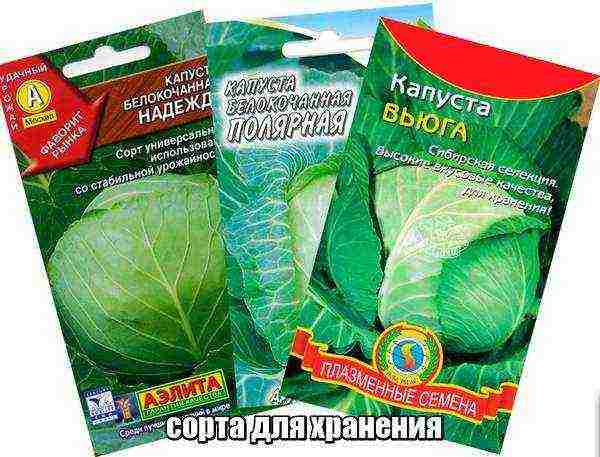
In recent years, due to the increased summer temperatures, the formation of heads of cabbage has been delayed or stopped altogether. For these conditions, breeders have created heat-resistant hybrids:
| Name | Vegetation period, days | Head of cabbage weight, kg |
| Ilona | 110 — 115 | 1,6 — 2,3 |
| Orbit | 134 — 152 | 2,5 — 3 |
| Maryana | 122 — 130 | 2,5 — 3 |
| Valentine | 130 — 140 | 4 |
| Olympus | 110 — 115 | 3 — 8 |
| Valentine | 140 — 180 | 1,5 — 2 |
The varieties bred for extreme conditions have a compact, developed rosette, which allows them to retain their thickening and get a larger head of cabbage in high heat.
Dutch varieties
Cabbage grown from Dutch seeds occupies one of the top positions when summer residents choose a suitable variety. Dutch breeders offer varieties for long-term storage, for fermentation, with improved taste.
True, one variety cannot combine all the necessary qualities. Therefore, when choosing, you should decide what cabbage is needed for, and choose a variety that is suitable for specific climatic conditions.
The best late varieties of Dutch selection are:
| Variety name | Vegetation period, days | Head of cabbage weight, kg |
| Galaxy F I | 130 — 135 | 4 — 6 |
| Fundaxi F I | 130 — 135 | 4 — 6 |
| Roxy F I | 125 — 135 | 2 — 3,5 |
| Furios F I | 125 — 130 | 3 — 5 |
| Ammon F I | 125 — 135 | 4 — 6 |
| Arrivist F I | 110 — 115 | 2 — 5 |
Dutch varieties are resistant to fusarium wilt, have dense elastic heads of cabbage and are suitable for long-term storage. They have excellent taste and are used for fermentation.
The best varieties of cabbage for pickling
What parameters should be used to choose cabbage for pickling?
The most important criterion is the ripening time. Early varieties have tender and succulent leaves that become soft when processed. These varieties are grown for fresh use.
For fermentation, medium-late and late-ripening varieties are suitable, which have gained a sufficient amount of biologically active substances, with dense heads of cabbage and juicy leaves.
The best taste is sauerkraut made from heads of cabbage with the following characteristics:
- The color on the cut is white;
- Cabbage stump no more than 1/3 of the height of the head;
- Thin leaves;
- Slightly sweet taste.
It is believed that in order to improve its taste, cabbage should be "grabbed" by frost, after which it becomes more sugary.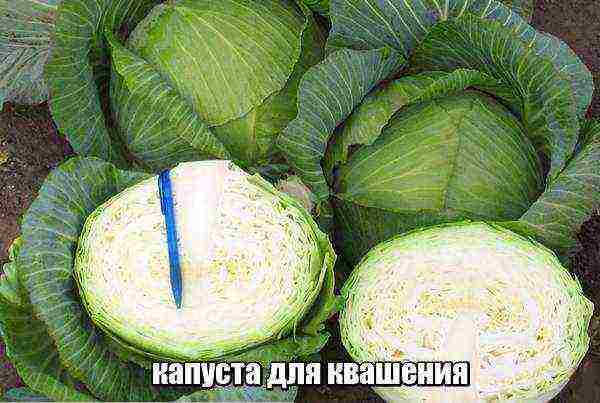 The best varieties for fermentation are:
The best varieties for fermentation are:
- Guarantor F I. The growing season is 140 days, the weight of the head is 2 - 3 kg. Recommended for fermentation during storage periods and immediately after harvest;
- Countess F I. Ripening period 85 - 90 days, head of cabbage weighing 2 - 3 kg. Resistant to disease and cracking;
- Filibuster F I... The growing season is 120 - 130 days, the weight of the head of cabbage is 2.8 - 3.6 kg. Has a dense structure and a pleasant taste when fermented. Differs in disease resistance;
- Flagship F I. Ripening period 115 - 120 days, head of cabbage weighing 3.4 - 4.1 kg. Differs in resistance to fusarium and amicable ripening;
- Zastolny F I... The growing season is 115 - 125 days, the weight of the head of cabbage is 3.5 - 5.5 kg. It is characterized by high resistance to cracking and amicable ripening.
The time-tested and recognized as the best varieties for fermentation are Amager 611, Moscow late, Belorusskaya 455, Nadezhda, Podarok, Slava 1305.
Fermentation is carried out throughout the entire storage period; cabbage of these varieties does not lose its taste over time, of course, subject to storage conditions.
White cabbage variety "Kolobok F I"
The high-yielding hybrid Kolobok F I, obtained at a Russian breeding station, is recognized as the leader among late varieties by Russian summer residents.
This is due to two main qualities observed in the heads of this variety - the absence of bitterness and resistance to cracking.
Cabbage of this variety is perfectly stored for a long time, retaining its taste and nutritional qualities.
The growing season is 150 - 165 days, the weight of the head of cabbage is 3 - 3.5 kg. Heads of cabbage on a cut are yellowish-white, outer leaves are green, a small inner stalk. Productivity from 1 sq. m reaches 10 - 12 kg.
Cabbage Kolobok loves fertile soil and abundant watering. During the period of growing leaf mass, fertilizing with nitrogen fertilizers is required, when heads of cabbage are formed - with potassium-nitrogen fertilizers.
Possesses medium resistance to fusarium, bacteriosis, gray and white rot. Differs in versatility in use: for storage, fermentation, processing.
Kohlrabi - the best varieties
Kohlrabi, or northern lemon, contains up to 50 mg (per 100 g of the product) of vitamin C, which makes it an especially valuable product in winter.
A thickened stalk of light green or purple color, similar to a turnip, is used for food. Like other types of cabbage, kohlrabi has early, mid and late ripening varieties.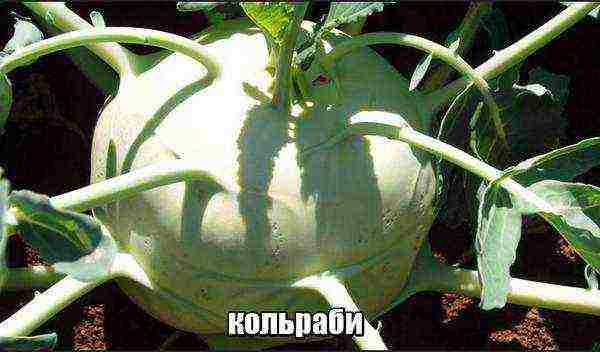
For long-term storage, the following varieties of kohlrabi are used:
| Variety name | Vegetation period, days | Stalk mass, kg |
| Violeta (purple) | 100 — 110 | 1,5 — 2 |
| Kossak F I (light green) | 120 — 130 | 0,4 — 0,8 |
| Natalka (purple) | 115 — 130 | 0,5 — 0,7 |
| Globe (light green) | 130 — 150 | 3 — 5 |
| Giant (light green) | 90 — 100 | 5 — 7 |
The Gigant variety has gained particular popularity, featuring large stems and high yields. The variety is characterized by excellent indicators of keeping quality and resistance to diseases. And with short ripening periods, it becomes possible to grow two crops.
The following varieties are most suitable for the climatic conditions of the middle lane:
- Early;
- Atena;
- Blue;
- Optimus is blue;
- Viennese white and blue;
- Purple;
- Delicacy white and blue.
Overgrowing, the stem grows rough and unusable, so carefully study the timing of ripening and harvesting... For most varieties, the harvest period begins when the stalk reaches 7-8 cm in diameter.
Late varieties of red cabbage
Red cabbage is significantly superior in nutritional value to a white cabbage relative. It contains 2 times more vitamin C compared to white cabbage and 4 times more carotene. It contains the dye anthocyanin (which helps to strengthen the capillaries), highly active phytoncides and is characterized by a very low carbohydrate content, which makes it a valuable product for diabetics.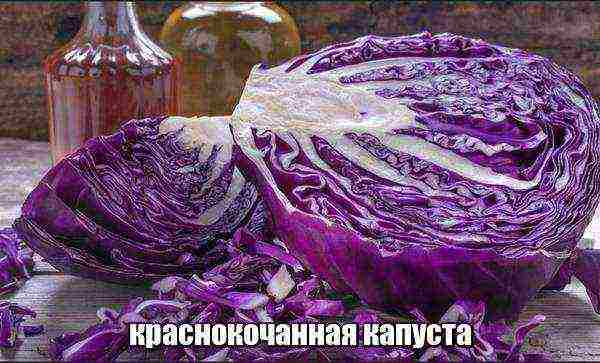
Among vegetable growers, the late varieties gained popularity:
- Gako 741. The growing season is 130 - 150 days, the weight of the head of cabbage is up to 3 kg. Possesses high indicators of keeping quality and is resistant to cracking;
- Late Langedeiker. The ripening period is 90 - 100 days, the head of cabbage reaches 2 - 3 kg. Stored with preservation of nutritional value up to 6 months;
- Maxila. The growing season is 150 - 160 days, the weight of the head of cabbage is up to 3 kg. Resistant to cracking, used for long-term storage;
- Mars. Ripening period 140 - 160 days, head of cabbage up to 1.5 kg. It is characterized by high yields and good taste, and is resistant to cracking.
Red cabbage is more cold-resistant and has a long growing season in comparison with white cabbage, it has smaller heads of cabbage.
Red cabbage juice is used to successfully treat diseases of the upper respiratory tract and intestines, atherosclerosis, anemia, high blood pressure.
Choosing the best variety of cabbage
If the variety was grown in climatic conditions suitable for it with the observance of the necessary conditions of agricultural technology, then it should be expected that the keeping quality and taste will be at the expected level.
Varieties intended for long-term storage during the harvesting period do not possess the completeness of the taste and nutritional characteristics that are acquired during the maturation process. These varieties include Winter 1474.
The Dutch hybrids Marathon, Bartolo and Lennox are characterized by excellent keeping quality.
Varieties Geneva, Türkis, Aros are recommended for cultivation in Siberia and the Urals.
The Timiryazev Academy catalog lists the varieties most suitable for growing in the middle lane: Aros F I, Bingo F I, Kalorama F I, Lezhky F I, Latima F I, Rusinovka, Tranzam F I.
In order for the cabbage to fully reveal the inherent advantages of the variety, choose the variety that is suitable for your climatic conditions. Then the harvest will correspond to the expected indicators.
Rate the quality of the article. We want to be better for you:


